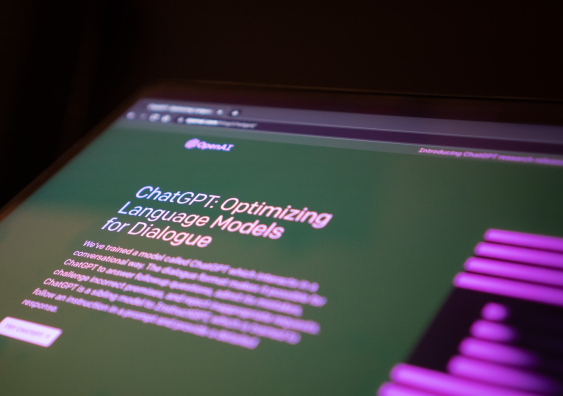ChatGPT offers a quick solution for writing cover letters, but how effective is it?
Have you ever written a cover letter from scratch? Many of us use the “Frankenstein approach”, blending cover letters from our close friends with those from strangers on the internet and then tailoring them to our specific needs.
Why can we do that? Because cover letters often follow a straightforward template. Typically, people begin their cover letters with a brief introduction that mentions the position they’re applying for, where they found the job listing, and why they’re excited about the opportunity.
They then structure the body of the letter to highlight their most relevant qualifications, using specific examples to show how their skills match the job requirements while also addressing any potential concerns, such as gaps in their resume. The conclusion usually reiterates their interest in the role, expresses enthusiasm for the opportunity to interview, and includes a note of thanks to the reader for their consideration.
Given this common template and the fact that common phrases are often abstract enough to apply to multiple companies, it seems like ChatGPT would be the perfect tool for writing cover letters. But is it really?
How “AI fluent” are you?
The answer to that question depends on your skill level in using ChatGPT. To explore this further, here’s an exercise from a new class at UNSW Business School, AI Fluency, that you can try if you’re in the market for a new job.
This exercise demonstrates an interesting pitfall when using ChatGPT for cover letters and how to avoid it. In 1 of the early workshops, we separated the class into 2 groups: 1 group acted as job applicants, and the other as an HR team responsible for hiring. We then handed the job applicants a printout of the job application, which was for a summer intern role as a business analyst. The applicants were given just 1 minute to use ChatGPT to write a cover letter for the job. Afterwards, we asked them to rate their cover letters out of 10.
When a few of the applicants read their cover letters aloud, the HR team was impressed. The letters were fluid, articulate, and well-written. The students themselves admitted that the letters were quite good – certainly better than most cover letters from undergrad applicants 5 or more years ago, and definitely an improvement over the summer internship applications we and our friends submitted fifteen-plus years ago.
Media enquiries
For any related media enquiries, please contact Katie Miller.
Tel: 0408 033 715
·ˇłľ˛ąľ±±ô:Ěýkatie.miller1@unsw.edu.au
However, as we moved on to the second cover letter, something became apparent. It sounded almost identical to the first one – not because it wasn’t fluid, articulate, and well-written, but rather because it was nearly verbatim the same as the 1st. The same issue arose with the third cover letter, and again with the fourth. Imagine being an HR professional and receiving nearly a dozen cover letters that were virtually identical! This scenario likely played out for many recruiters in early 2023, at the start of the ChatGPT hype.
The importance of accurate prompts
A key aspect of this exercise was the time limit, which meant that savvier students couldn’t add more personalised details or edit their cover letters beyond using a basic prompt like, “Hi ChatGPT, I am applying for the role of Business Analyst at Visionary Consulting; can you write me a cover letter?” This exercise highlights a broader lesson: many people focus solely on their use of GPT without considering that others are also using ChatGPT simultaneously.
In the second round, we extended the time limit, giving participants up to 10 minutes to write their cover letters. The goal we set for them was clear: use ChatGPT as much as possible but avoid any dead giveaways that it was used. Beyond giving students more time, we also provided a digital copy of the job advertisement so they could copy and paste relevant aspects from the advertisement document directly into ChatGPT. Some students finished within 5 minutes, while others took the full 10 minutes, using prompts to add more details and personal experiences to their cover letters.
Right (and wrong) ways to personalise cover letters
We then asked participants to read their cover letters aloud, starting with those who had finished earlier. The letters were noticeably improved compared to the first round, but occasionally, a phrase would slip in that betrayed the use of ChatGPT.
For instance, one student’s letter included the phrase, “My goal is to revolutionise the fintech industry.” Beyond being a lofty ambition, the phrase is out of place for an entry-level internship position. When we asked the class what might have given away the use of ChatGPT, no one pointed to this phrase because it blended seamlessly into the letter’s context. I then asked the students to imagine an interviewer asking about their personal career goals. If they didn’t genuinely respond with the aspiration to “revolutionise the fintech industry”, this inconsistency could raise red flags and potentially cost them the job.
Other students took the time to add more personal details and instructed ChatGPT to adjust the tone of their letters, making them sound less generic and more aligned with their individual voices. These cover letters were noticeably stronger.
Results and example cover letter prompts
Following are some of the prompts that students used to generate cover letters, building from basic (level 0) through to a more specific prompt (level 3) – and how they can be customised for your own prompts:
Level 0: Hi ChatGPT, I am about to graduate from university, and am applying for jobs. I would like help making a job cover letter for [insert role title] at [insert organisation name].
Level 1: Hi ChatGPT, I am about to graduate from university and am applying for jobs. I would like help making a job cover letter for [insert role title] at [insert organisation name]. Here are the key criteria and how I meet them:
[Insert numbered list of key criteria with 2-4 bullet points on how you address the key criteria]
Level 2: Add information on the company before noting how you meet the key criteria. Hi ChatGPT, I am about to graduate from university and am applying for jobs. I would like help making a job cover letter for [insert role title] at [insert organisation name]. Let me tell you about the company.
[Insert information on the company and role]
Here are the key criteria and how I meet them:
[Insert numbered list of key criteria with 2-4 bullet points on how you address the key criteria]
Level 3: Add instructions to personalise how the cover letter is written. When constructing the cover letter, make it interesting, and try to show how I can really assist their interest with my background. Make it sound individualised based on my personality. Key aspects of my personality include:
[list features that make you you!]
The best way to generate cover letters
As outlined above, the most significant improvement came from students who took a more methodical approach, crafting their cover letters paragraph by paragraph.
By working systematically and iteratively with ChatGPT, they were able to adapt the outputs to reflect their own language use and proficiency. Ultimately, this approach creates a stronger, more authentic, and more personalised cover letter than those produced by students who relied on a single set of instructions and asked ChatGPT to generate the entire letter in one go, which often resulted in cover letters with lofty, buried goals like “revolutionising the fintech industry”.
Leveraging ChatGPT for crafting cover letters is much like using a high-quality camera: while the tool can capture stunning images, it’s the photographer’s eye that composes the masterpiece.
So, the next time you use ChatGPT for a cover letter, remember that while ChatGPT can draft the lines, it’s up to you to provide the genuine substance that truly sets you apart.
Related stories
-

The latest version of ChatGPT has a feature you’ll fall in love with. And that’s a worry
-

A year of ChatGPT: 5 ways the AI marvel has changed the world
-

Two authors are suing OpenAI for training ChatGPT with their books. Could they win?
-

Charting a new course for university education in the age of ChatGPT





